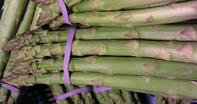
Propagation
Propagation is from seed.Planting Method
Direct sowing of asparagus seeds can be done but it is preferable to plant seeds in a nursery and approximately ten months later plant out only the strongest seedlings.
Draw a wide V-shaped furrow about 200 mm deep in the plant area and plant the seedlings (or young crowns) in the furrow and cover with 50 mm of soil.
Once the seedlings have settled and the crowns of the plants have formed and, as the plant grows, cover with the remainder of the ridged soil to ensure the crown is covered by 150 mm of soil.
Spacing
Plants should be spaced 20 to 30 cm apart in rows that are 150 cm to 200 cm apart. This is between 20 000 and 30 000 plants per hectare.Sowing Time
Sow seeds in late summer to early autumn and ten months later your seedlings or crowns will be ready to plant out.Planting Time
Planting is done in early spring to early summer. From August to the end of November in South Africa.Growth Period
Asparagus plants can last for up to 15 years. The growth period when spears are produced and harvested is from October through to March. Late spring to early autumn.Fertilization
Before planting, a soil analysis should be done to ascertain the nutrient requirements. If soils are too acid, then lime must be applied and ploughed into the soil at least a month before planting.
Just before planting commences an application of chicken manure or at least 1000 kg of NPK mixture 2:3:2 should be worked into the top 400 mm of soil. Once the plants have settled and the first signs of the spears are seen, apply a further 800 kg per hectare of 2:3:4.
Once the first spears have been harvested a further nitrogen application in the form of a 150 kg per hectare of LAN can be spread along the plant rows.
A final post-harvest application of 150 kg per hectare of LAN can be given six weeks after the harvest period.
Irrigation
Apply 25 to 30 mm of irrigation per week until the root system is well established and thereafter these applications can be extended to every 14 days throughout the harvesting period.
If rain occurs these irrigations can be shortened and in extreme drought or warm low humidity weather the applications can be increased.
Either way make sure to practice soil moisture monitoring whether by neutron probe, tension meters or by manual means using a spade or augur.
By Louise Brodie